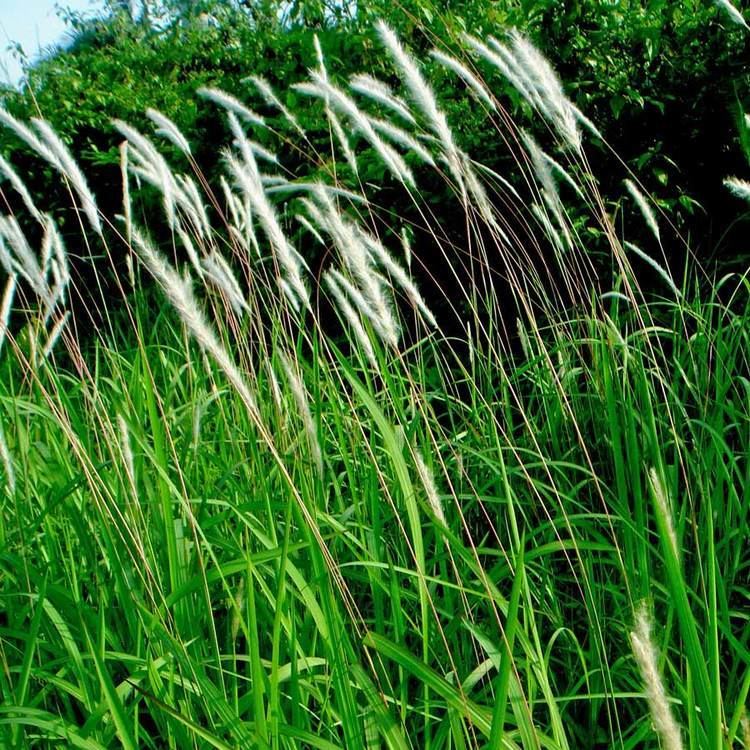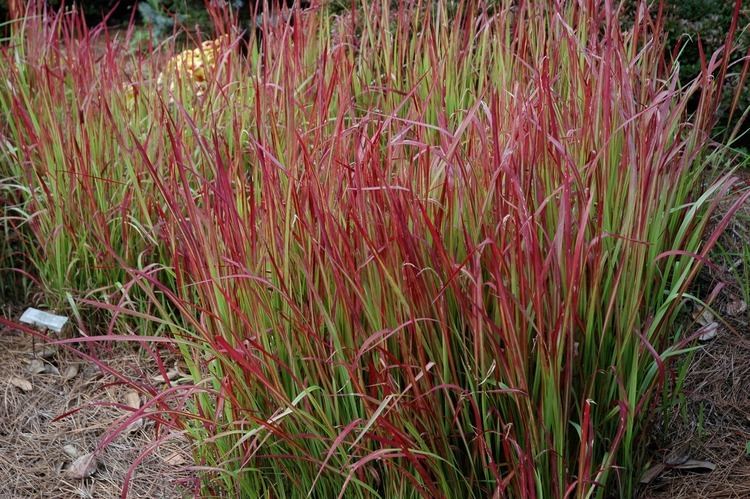Tribe Andropogoneae Rank Species | Genus Imperata Higher classification Imperata | |
 | ||
Similar Imperata, Grasses, Chinese silver grass, Fountaingrasses, Pampas grass | ||
Cogongrass imperata cylindrica
Imperata cylindrica, commonly known as cogon grass /koʊˈɡoʊn/, kunai grass /ˈkuːnaɪ/, or blady grass. is a species of grass in the genus Imperata. It is placed in the subfamily Panicoideae, supertribe Andropogonodae, tribe Andropogoneae. Red cultivars of the species grown as ornamental plants are known as Japanese bloodgrass.
Contents
- Cogongrass imperata cylindrica
- How to identify cogon grass imperata cylindrica
- Cultivation and uses
- Weed problems
- Flammability
- Phytochemistry
- Taxonomy
- Common names
- References

It is a perennial rhizomatous grass native to east and southeast Asia, India, Micronesia, Melanesia, Australia, and eastern and southern Africa. It grows from 0.6 to 3 m (2 to 10 feet) tall. The leaves are about 2 cm wide near the base of the plant and narrow to a sharp point at the top; the margins are finely toothed and are embedded with sharp silica crystals. The main vein is a lighter colour than the rest of the leaf and tends to be nearer to one side of the leaf. The upper surface is hairy near the base of the plant while the underside is usually hairless. Roots are up to 1.2 meters deep, but 0.4 m is typical in sandy soil.

How to identify cogon grass imperata cylindrica
Cultivation and uses
It is used for thatching the roofs of traditional homes throughout south-east Asia.

It is planted extensively for ground cover and soil stabilization near beach areas and other areas subject to erosion. Other uses include paper-making, thatching and weaving into mats and bags. It is used in traditional Chinese medicine.

A number of cultivars have been selected for garden use as ornamental plants, including the red-leaved 'Red Baron', also known as Japanese blood grass.
Young inflorescences and shoots may be eaten cooked, and the roots contain starch and sugars and are therefore easy to chew.
It is used as an ingredient in the skincare brand Kiehl's Ultra Facial Cream for its high concentrations of potassium which provides a hydrating effect. Their website also states that indigenous native Australians may have used the plant as a substitute for salt due to its high saline content.
Weed problems
The plant has become naturalized in the Americas, Northern Asia, Europe and Africa in addition to many islands and is listed as an invasive weed in some areas. In the U.S. it survives best in the Southeast (and, according to a 2003 survey, has overtaken more acreage in that region than the notorious kudzu), but has been reported to exist as far north as West Virginia and Oregon. Worldwide it has been observed from 45°N to 45°S. It grows on wet lands, dry lands, areas of high salinity, organic soils, clay soils and sandy soils of pH from 4.0 to 7.5. It prefers full sun but will tolerate some shade. In Florida I. cylindrica is found in areas where the soil has been disturbed, such as roadsides, building sites, timber harvesting areas, and borrow pits. It is able to invade both moist and dry upland pine forests. Once established it often forms dense monocultures.
In addition to outcompeting species for resources, the grass also exhibits allelopathic tendencies. The chemicals it releases as well as the dense mat of vegetation that usually accompanies a cogon grass invasion gives it an advantage over indigenous plants.
It spreads both through small seeds, which are easily carried by the wind, and rhizomes which can be transported by tilling equipment and in soil transport.
In the Southeastern United States, state governments have various eradication efforts in place, and deliberate propagation is prohibited by some authorities. Control is typically by the use of herbicides. Currently, the most effective herbicides used to control growth are glyphosate and imazapyr. Burnoff is seldom successful since the grass burns at a high temperature causing heat damage to trees which would ordinarily be undamaged by a controlled burn and recovers from a burn quickly. Quarantine and extermination of this plant is especially difficult because cogon grass establishes root systems as deep as four feet, and regrowth can be triggered by rhizome segments as small as one inch.
Cogon grass is difficult to contain mainly because it is highly adaptive to harsher environments, establishing itself on soils low in fertility. The grass also can grow on sand and clay, and consumers of it are few. The grass tends to be averse to dense shade, but reports indicate more shade-tolerant strains are developing.
The legume vine Mucuna pruriens is used in the countries of Benin and Vietnam as a biological control for Imperata cylindrica.
Flammability
Anecdotal and empirical evidence suggests that types of this grass are quite flammable even when apparently green, particularly in Southeast Asian climates. It is not uncommon to see hillsides of cogon grass on fire.
A common expression in the Philippines is ningas cogon ('cogon brush fire'). It is a figure of speech for procrastination, specifically people who show a fervent interest in a new project but lose interest quickly, in reference to the propensity of cogon grass to catch fire and burn out quickly.
Phytochemistry
The plant contains the triterpenoids arundoin, cylindrin and fernenol.
Taxonomy
Imperata cylindrica was first described by Linnaeus in 1759 under the basionym Lagurus cylindricus. They were renamed by the French entomologist and botanist Palisot de Beauvois to the current accepted name of Imperata cylindrica.
Synonyms include:
Common names
The species is most commonly known in English as "cogon grass", from Spanish cogón, from the Tagalog and Visayan kugon. Other common names in English include kunai grass, blady grass, satintail, spear grass, sword grass, and thatch grass, among other names.
In East Asia it is known 白茅 (báimáo) in Standard Chinese; 띠 (tti) in Korean, and チガヤ (chigaya) in Japanese. In Indochina it is known as kyet-mei or thetke in Burmese; ស្បូវ (sbauv) in Khmer; ຫຍ້າຄາ (yakha) in Laotian; หญ้าคา (yah-ka) in Thai; and cỏ tranh in Vietnamese.
In maritime Southeast Asia it is known as halalang in Banjarese; kugon, parang, or ilib in Filipino; alang-alang in Indonesian; lalang in Malaysian; and eurih in Sundanese. In Oceania it is known as gi or ngi in Fiji; kasoring in Palau; and kunai, kuru-kuru, kawva, or auturra in Papua New Guinea.
In Western and South Asia it is known as sill or sulel in Arabic; kush in Bengali; chero, dabh, modewa gaddi, oloo, and tharpai pullu in India; darbai-pul, illuk, or inanka-pilu in Sinhala.
In Africa it is known as baya, ndongo limba, or sosongo in Cameroon; binkba, moto-moto, or nianga in Congo and the Democratic Republic of the Congo; nse in Côte d'Ivoire; nyeki in Kenya; manevika or tena in Madagascar; lalang in Mauritius; ata, ekan, gasa kigere, ias, soyo, tibin, tofa, or zarenshi in Nigeria; mohlorumo or um tente in South Africa, doiya or mayani in Sudan; chimabi, moto-moto, or sanu in Tanzania, dis in Tunisia; and ibamba, luwamba, or silenge in Zimbabwe.
In Europe, it is known as xisca in Catalonia; paillote or paille de dys in France; xiphara in Cyprus; Blutgras or Siberhaargras in Germany; falasco bianco in Italy; and carrizo, cisca, cogón, or marciega in Spain.
